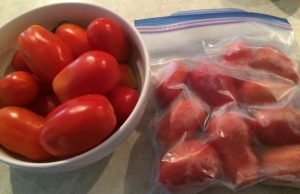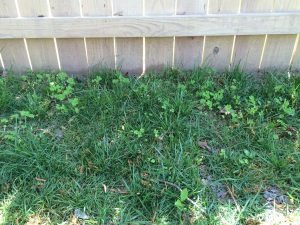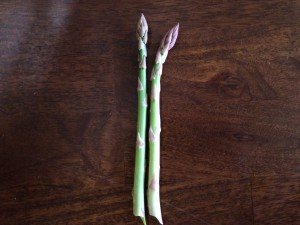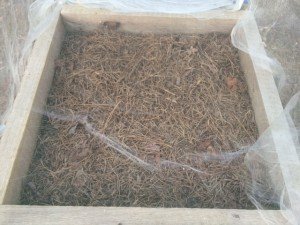Under the best of circumstances July is an awkward time for the garden.Spring greens (spinach, lettuce, cilantro) still in the garden have bolted or browned, strawberries have stopped producing anything but dozens of straggly runners and asparagus has transmogrified into its less known, fuzzy small tree form. Between these only-a-mother-could-love-them beauties are the bare spaces where sugar and snow peas and pak choy have been removed but it is still too early to sow fall plants, July may be the worst time to have a garden guest.I have a garden guest coming next week.The wonderful REALTOR that patiently waited and watched while I stood in potential back yards mentally calculating full sun hours and painstakingly measuring for raised beds that were at the time, stored in a rented garage, is coming to see what I "have done with the place" and late July is the date we picked for dinner and a garden tour.This post is half garden update, half convincing myself that there are still beautiful things to be seen even in this straggly season. Here goes:The blackberries are huge and I should still have a good mix of ripe and unripe next week.I always overseed plants like basil so I can use the thinnings on meals while letting the main plants mature.There is only one butternut squash on the vine so far, but many blooms.I picked my first round of Envy edamame with only a handful left in the garden, but I had left the wonderful nitrogen fixing plants in the garden as companion plantings to everyone else.And the rest of this story is tomatoes, the beauties of summer. These are some of the Blue Cream Berries cherry tomatoes before they ripen and take on that creamy yellow color.The roma tomatoes are thick on the vine and ripening at a steady rate.A pretty average harvest day with a double handful of roma tomatoes, a couple of Mortgage Lifters, a bowlful of Hartman's Yellow Gooseberry cherry tomatoes (the most prolific and tallest of my cherry tomato plants this year) and my first Black Beauty zucchini of the year.Here's hoping she really likes tomatoes ;)
Read MoreRoma Wasn't Built In a Day
Roma math:A decent batch of homemade tomato sauce with enough to freeze or can for future use requires a minimum of 15-20 lbs of roma tomatoes.The average day on the urban farm (with 16 roma tomato plants in high season) results in anywhere from 1-3 lbs of roma tomatoes.I struggled with this math last year as I watched ripe romas edge toward over-ripeness while waiting for enough companions to be ready at roughly the same time to make a batch of sauce. Out of desperation I started searching "freezing whole tomatoes" and low and behold:Not only CAN you freeze whole tomatoes, there are a couple of benefits to doing it. Freezing, especially for short term storage doesn't have to be particularly fussy. Just clean, pop in a bag, remove most of the air and voila - a partial batch of sauce! Also, when frozen tomatoes are thawed to make sauce, the skins just slide right off, saving the blanching step.
Read MoreFood With a Story - Mortgage Lifter
When was the last time you ate a tomato and considered the intrigue and controversy surrounding it's provenance?This big guy, sold by Baker Creek under the name Mortgage Lifter is almost ready to harvest and when I save the seeds after enjoying my first taste of this storied heirloom fruit, I will be thinking of the dueling stories of where it originated. A little food for thought ;)
Read MoreTowering Tomatoes
The view standing next to my Hartman's Yellow Gooseberry Tomato.The view a few steps back. This tomato plant has already over taken the 8 foot bamboo support pole and I need a step ladder to access the top with many months of growing still ahead. Watch out Charles Wilbur...
Read MoreSeeing Red (And Green)
Today's garden science lesson: pill bugs can produce offspring up to 3 times per year and they like strawberries. Not all of the strawberries, of course, just a pill bug sized sampling of each.I picked berries between the intermittent rains this morning and for every two berries I put in my bowl, another one went into the compost some with the pill bugs still happily munching away.The leaf litter from last year's growth coupled with the shade from this year's lush growth has provided the perfect habitat for pill bugs and now that the berries are ripening, they don't even need to leave home to get dinner. I am going to try to clean as much of it as I can before I get to do the hard cleaning for winter.The Sugar Ann snap peas are coming in by the handful now. Enough to snack on while walking the garden.
Read MoreThe New Normal
The phrase "the new normal" usually has all the cheer of a dark, grey storm cloud with it's reference to sluggish GDP growth, wage stagnation and growing wealth inequality, but there is another new normal that is happening parallel to the business one that has a bit of a silver lining quality to it - the rise of urban and suburban farming.There has been a definite uptick in the number of news stories about urban agriculture over the past couple of years, but I found this recent bit of research by Redfin particularly illustrative of how the backyard garden has moved to the forefront. With my own metro ranking #10 and fully 12.7% of listings studied having the word 'garden' presumably as a selling feature, urban and suburban food production might just be the new normal.
Read MoreI Break For Blossoms
I took a break between tending to existing plantings (pruning, mulching, thinning, tying up) and starting on seeding new plantings (cilantro, cucumber, edamame, squash and zucchini) to enjoy the blossoms that beginning to pop up around my garden.Sugar Ann Sugar Snap Peas:Blue Berries Cherry Tomatoes:Ahhhhh! Okay, back to work.
Read MoreBerry Delicious
First* strawberry of spring!*technically the third one to ripen, but the first one that I beat the birds to. The strawberries are now covered enough to keep birds and squirrels out but let the pollinators in.
Read MoreOne Boy, Three Sisters
Me: Let me snap a picture before you plant the rest of the seeds.9yo: Sure, but let me grab the dibber first!I served in an advisory capacity last weekend as my 9 year old planted Glass Gem and Strawberry Popcorn, two beautiful heirloom varieties of flint corn he chose for his own garden crop this year. I chose California Blackeye Peas and a gift of Italian squash seeds called Zucchino Tondo Chiaro Di Nizza to be planted with the corn over the coming weeks to create our own Three Sisters planting with our crops growing together, supporting and benefiting each other.As we worked we talked about proper spacing (math), germination (biology), the magic of life held in each one of the seeds in his hand (reverence), and of the future harvest (patience).There is more growing in my garden than just food, I am growing a person.
Read MoreA Berry Short Haircut
Last fall I had a niggle as I watched the lush, green growth of the strawberries yellow in some places and brown in other. I made a cursory search for winterizing strawberries and fall strawberry preparation and did not find what I was looking for, so called it good and lived in ignorant bliss all winter.This year, as spring sprung and my strawberry plants reached an almost concerning level of denseness while thickly mulched with some of last years dying and crumbling growth, I searched again and still came up with nothing and went back to my bliss and the rest of my to-do list.Then a few weeks ago I saw a video from Curtis Stone visiting a farmer in New Zealand, who, by the way, fetched 661 lbs. of strawberries off of his 600 first year plants discussing between 3:55 - 6:05, cutting down the current year's growth to force the plant into new, disease and fungus free growth for next year.My June Bearing Strawberries are already thickly in bloom, covered in green strawberries and tonight I saw the first blush of pink. Since I cannot do anything else until the end of this year's growing season, I went back to my research and found that a slightly different search term (cutting back strawberries) yielded the result I was seeking.This is one of those bad news/good news things.Bad news: The only thing I can really do between now and the end of season when I can cut back the green growth and make clean beds for next year, pulling out the older plants, making room for newer growth, is hand cleaning some of the decaying leaves, using them for mulch on very different plants so as not to transmit any fungus or disease between cultivars.Good news: In this case, that persistent niggle is my good news. I am far from an expert and I don't hold the title Master Gardener, but I am beginning to have a real intuition, a sense of what might need to be researched and considered for my various plants. I do consider myself a pretty good researcher and on this one I missed my target more than once, but I am feeling good that I have an idea of which questions need to be asked and will listen even more closely going forward. Answers, clearly, may vary!#Kaizen
Read MoreGreen Mulching
While looking for a readily available, organic mulch to compliment my semi-composted pine needles, I have learned that the list of mulching styles and materials is truly endless. The list of possibilities include but is not limited to: sheet mulching, lasagna mulching (which does not actually involve pasta), plastic mulching, deep mulching, green manure mulching (which is green, but not manure), straw mulching...as I said, endless.The option I found most interesting is green mulching, using plant matter that would otherwise go into the compost bins, instead applied directly on the soil as a biodegradable mulch, effectively cutting out the middleman.I have begun this process primarily with weeds in my yard and the few volunteer plants that come up in my garden. This week the main contributor has been the Yellow Woodsorrel that has popped up in clumps all around my yard.Yellow Woodsorrel, so called for the small, yellow flowers it produces, is an edible forage green that is commonly called 'false clover' in the midwest. It has appeared this year in such abundance that I can both have my cake and eat it too by using it as a primary green mulch. Below is the result of just a few minutes worth of pulling sorrel and mulching between asparagus crowns.For my foraging friends, the other edible forage plant I have in abundance this year is Common Chickweed. It has been blooming for months so I use it as a wild edible, but not as mulch to avoid introducing new seeds into the garden.The trick with using any plant you find in your yard (weed, grass or otherwise) as green mulch is to make sure you do not include the flowers or seeds. Even when the flowers seem small and closed it is better to pluck them off before tossing them between plantings."Earth knows no desolation. She smells regeneration in the moist breath of decay." ~ George Meredith
Read MoreFinally Spring - Garden Update
The average last frost date for this area has come and gone and the lowest nighttime temp forecast through the end of the month is 41. I think spring is finally here to stay!The French Breakfast Radishes are speeding toward their 25 days to maturity and the Lollo De Vino Lettuce is by far, the prettiest lettuce I have ever grown.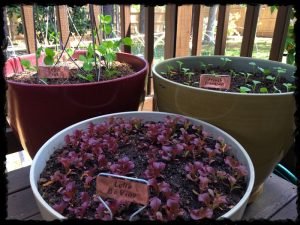 The strawberries are already thickly covered in blooms and green berries.
The strawberries are already thickly covered in blooms and green berries.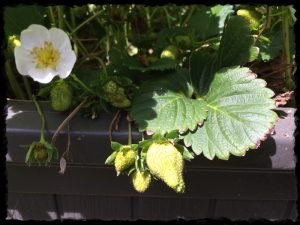 And speaking of "thick", the June-bearing variety I have put out an outrageous number of runners. I tried to stay on top of it last year, giving away dozens of rooted starts and adding many more to the compost bin, but they still managed to do a little guerrilla gardening of their own, sneaking out some late season runners to plant offspring around the designated 4'x8' beds.
And speaking of "thick", the June-bearing variety I have put out an outrageous number of runners. I tried to stay on top of it last year, giving away dozens of rooted starts and adding many more to the compost bin, but they still managed to do a little guerrilla gardening of their own, sneaking out some late season runners to plant offspring around the designated 4'x8' beds. The blueberry bushes are also covered in unripe berries and continuing to bloom. This is their second summer in place and I am hoping the January pruning results in even larger, more plentiful berries than last year.
The blueberry bushes are also covered in unripe berries and continuing to bloom. This is their second summer in place and I am hoping the January pruning results in even larger, more plentiful berries than last year.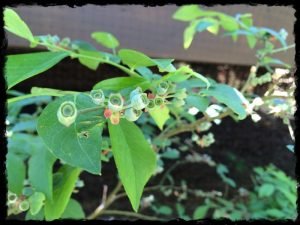 I am growing 2 varieties of Sugar Snap Peas this year, finishing out the last of my Sugar Anns and also growing a variety call simply Sugar Snap.
I am growing 2 varieties of Sugar Snap Peas this year, finishing out the last of my Sugar Anns and also growing a variety call simply Sugar Snap.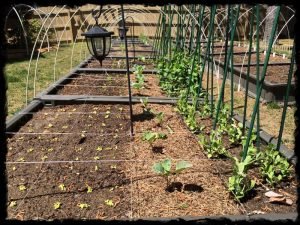 The collards and lettuces in the garden are off to a slow start which I attribute to the mostly cooler weather we have had this spring. With daytime highs starting to reach into the high 70s and low to mid 80s, I think their growth rate will pick up quickly in the next few weeks.And last, but never least, the tomatoes.
The collards and lettuces in the garden are off to a slow start which I attribute to the mostly cooler weather we have had this spring. With daytime highs starting to reach into the high 70s and low to mid 80s, I think their growth rate will pick up quickly in the next few weeks.And last, but never least, the tomatoes.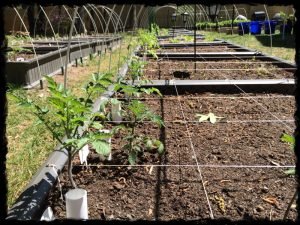 Of the 38 tomatoes that were emancipated at the end of March, I have 37 that are doing very well. The septoria leaf spot has dramatically slowed in it's progression since they were moved outside and the one Rebekah Allen tomato plant that was lost to a nighttime nibbler, has been reseeded indoors and will be replaced outdoors in a month or so.This weekend I will be sowing more herbs in the front and reseeding some of the spinach that has had less than stellar germination rates this year."In the spring, at the end of the day, you should smell like dirt." ~ Margaret Atwood
Of the 38 tomatoes that were emancipated at the end of March, I have 37 that are doing very well. The septoria leaf spot has dramatically slowed in it's progression since they were moved outside and the one Rebekah Allen tomato plant that was lost to a nighttime nibbler, has been reseeded indoors and will be replaced outdoors in a month or so.This weekend I will be sowing more herbs in the front and reseeding some of the spinach that has had less than stellar germination rates this year."In the spring, at the end of the day, you should smell like dirt." ~ Margaret Atwood
Avant Garden
The single, yellowed leaf I found on one of my paste tomatoes at the end of February was actually the opening shot of a fungal tug-of-war that will likely continue for the whole of 2016's growing season. The Septoria Leaf Spot fungus which can cause damage to tomatoes by defoliation leading to sunburned fruit has been mostly contained by removal of affected leaves and regular use of a homemade organic fungicide (1 gallon of water, 2 TBS vegetable oil and 2 TBS baking soda) but the close proximity of the plants to each other while they are stuck in my indoor grow room was almost certainly encouraging the spread of the fungus.With about a week to go before the last frost date for my area, I have been obsessively checking the 15 day weather forecast for the past few days to determine whether I could risk putting the tomatoes out a little early to give them some much needed space, fresh breezes and sanitizing sunshine to inhibit the fungus from spreading. Today I rolled the dice and moved them to the great outdoors!The PVC tubes that my bamboo tomato supports fit into are already in place so the plant roots will not be disturbed later in the season when they are necessary and the tomatoes have been hardened off.Last year I had a handful of tomatoes that had blossom end rot so I saved eggshells all winter and crushed them into a powder to provide more calcium to the plants. Tomatoes are a vine plant that will root along their stem, so mine were laid down in the channel I dug rather than placed upright. Eggshells were spread beneath and on top of the root area.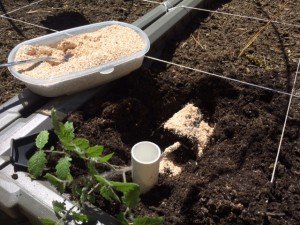 The stem is gently bent at a 90 degree angle several inches up from the top of the soil line from the starter cup. Roots will develop along this stem and according to Charles H. Wilbur, more roots will result in more tomatoes.
The stem is gently bent at a 90 degree angle several inches up from the top of the soil line from the starter cup. Roots will develop along this stem and according to Charles H. Wilbur, more roots will result in more tomatoes.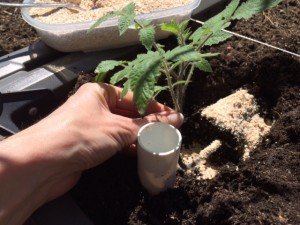 Soil is patted down over the tomato root and around the bent stem and any leaves touching or near ground level are removed to avoid splash up from the soil leading to new and exciting fungal infections.
Soil is patted down over the tomato root and around the bent stem and any leaves touching or near ground level are removed to avoid splash up from the soil leading to new and exciting fungal infections.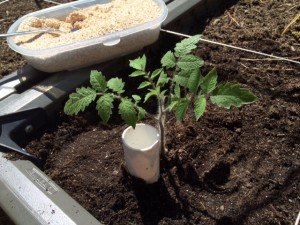 Repeat 37 more times then relax and start compiling fabulous tomato recipes like this one while you wait for the fruits of summer to appear!
Repeat 37 more times then relax and start compiling fabulous tomato recipes like this one while you wait for the fruits of summer to appear!
Making Lemonade
Unless I take the time to carefully pluck them out, one by one, before taking a garden pic, you have probably noticed the indecent number of pine needles lurking in the background of EVERY PHOTO I TAKE!Once upon a time I had big dreams of chicken wire leaf bins in my backyard to effortlessly convert the sweet gumball and maple leaves raked up each fall into garden gold over the course of a year. In these fantasies I would empty the bins the following fall and add the compost to my garden before starting the cycle over again.Instead, the home I purchased has pine trees. Loblolly Pine trees (Pinus taeda) to be exact and the leaves they shed do not turn into lovely compost over the course of a year but instead, remain defiantly pine needle-like for much, much longer.After a bit of debate and confirming that pine needles making soil acidic is actually an old wives tale, I decided to compost them anyway (note: this was my idea, not the pine needles').Then, magically, after two years of composting, I have...pine needles!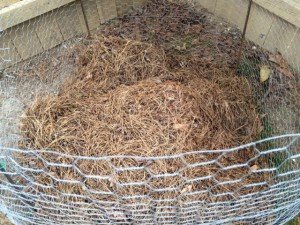 Pine needles don't turn into compost very quickly, but one of my goals this year is to mulch and I have been casting around for a sustainable, organic mulch that would work well in my garden beds. After two years of composting, I did get somewhat broken down needles that would work very well as a mulch.
Pine needles don't turn into compost very quickly, but one of my goals this year is to mulch and I have been casting around for a sustainable, organic mulch that would work well in my garden beds. After two years of composting, I did get somewhat broken down needles that would work very well as a mulch.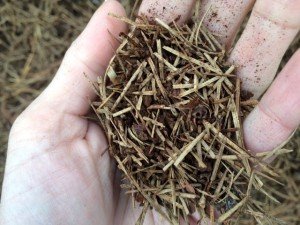 I started mulching around my transplanted collards while I wait for my direct sown spinach and sugar snap peas to fully sprout and I have to admit the result is quite nice.
I started mulching around my transplanted collards while I wait for my direct sown spinach and sugar snap peas to fully sprout and I have to admit the result is quite nice.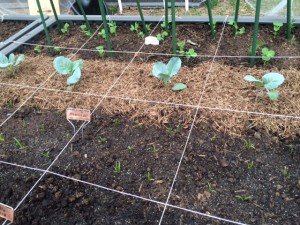 Because I have been turning the needles in their bin throughout the year, I know they hold moisture and attract earthworms so should work well as a mulch.
Because I have been turning the needles in their bin throughout the year, I know they hold moisture and attract earthworms so should work well as a mulch.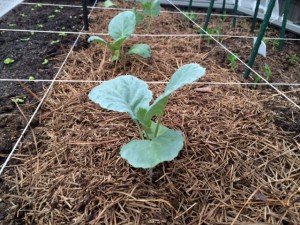 Okay, that was a completely gratuitous pic just because they looked so pretty.So now, I have made lemonade from my lemons and looking over my garden plan now I find myself in the position I could not have conceived of a year ago, I am not sure I have enough pine needles!
Okay, that was a completely gratuitous pic just because they looked so pretty.So now, I have made lemonade from my lemons and looking over my garden plan now I find myself in the position I could not have conceived of a year ago, I am not sure I have enough pine needles!
Paradigm Shift
I sometimes forget the prevailing notions people have related to growing food. The most common mental images seem to center around long hours of back breaking labor spent tilling, planting, hoeing and weeding.I am quickly reminded of the current thinking when I breezily say things like, "I planted 288 spinach plants today and need to do the same for lettuce tomorrow." and the person I am speaking with gapes in horror at the perceived amount of time and effort that goes into it. But the chasm between what they are thinking and what I actually did is as big as the Grand Canyon. We are operating under two VERY different paradigms when it comes to growing food...Depending on the agricultural model used, growing food can be relatively low-labor and the little time and money spent in the garden is subtracted directly from the time and money that would otherwise be spent driving to the grocery store, finding produce that is less nutritious and fresh, waiting in the checkout line to pay and then driving home on a daily or weekly basis.This morning I planted 36 Red Romaine lettuces and the whole process took about 20 minutes. I started with a homemade plant spacing tool made from plywood, cheap cabinet handles and recycled wine corks: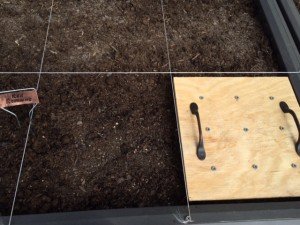
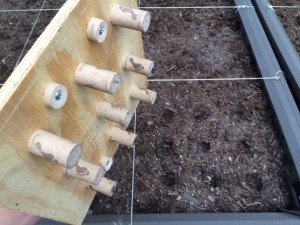 Lettuce can be planted 9 to a square foot so I pressed the spacer into 4 of my 1'x1' squares to leave divots where the seeds should be planted.Next I shook out some seed into my palm and placed 2 per divot. I normally have really good germination rates with the Baker Creek lettuce seeds, but these are last year's seeds so I did 2 to be safe. This was the most time intensive part of the whole operation but not what I would call laborious.
Lettuce can be planted 9 to a square foot so I pressed the spacer into 4 of my 1'x1' squares to leave divots where the seeds should be planted.Next I shook out some seed into my palm and placed 2 per divot. I normally have really good germination rates with the Baker Creek lettuce seeds, but these are last year's seeds so I did 2 to be safe. This was the most time intensive part of the whole operation but not what I would call laborious. When I was done I patted the soil over the seeds, lightly covering them and creating good dirt to seed contact then watered.
When I was done I patted the soil over the seeds, lightly covering them and creating good dirt to seed contact then watered.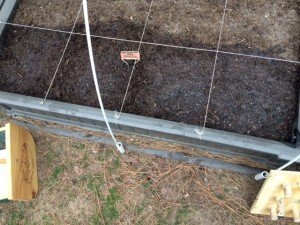 Voila!Yes there will be some watering throughout the season and yes, I do get an occasional volunteer plant that needs to be plucked out of my garden beds, but those are minor things, easily taken care of when I head out to my backyard grocery store each night and look around to see what's for dinner.
Voila!Yes there will be some watering throughout the season and yes, I do get an occasional volunteer plant that needs to be plucked out of my garden beds, but those are minor things, easily taken care of when I head out to my backyard grocery store each night and look around to see what's for dinner.
Springing Ahead
After a week of travel, timezone jet lag and leaping ahead an hour, I returned home to find my spring garden well underway. The blueberries and strawberries are already in bloom and hoping the 33 degree overnight currently forecast for Monday night doesn't damage them.
The blueberries and strawberries are already in bloom and hoping the 33 degree overnight currently forecast for Monday night doesn't damage them.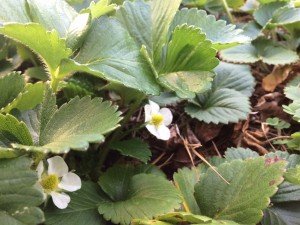 The collards, cabbage and kale have been hardened off and were transplanted yesterday near the sprouting spinach, pak choy, lettuce and sugar snap peas.
The collards, cabbage and kale have been hardened off and were transplanted yesterday near the sprouting spinach, pak choy, lettuce and sugar snap peas. The 8 spears of asparagus that have been harvested so far have been well worth the 1 year wait and I hope some crowns that have not yet produced will begin to send up spears soon. In the meantime, I am becoming an expert on making a little asparagus go a long way in dishes.
The 8 spears of asparagus that have been harvested so far have been well worth the 1 year wait and I hope some crowns that have not yet produced will begin to send up spears soon. In the meantime, I am becoming an expert on making a little asparagus go a long way in dishes.
Batting 500
Getting Back On The Grid
With the spring starts happily growing indoors and awaiting the last frost date in April, today's sunny, spring-like* weather meant getting down to the business of putting the square back in square foot gardening.I have tried a few different materials to mark off my grids over the years with all surviving only a single year's exposure. This year I am trying a nylon string made for outdoor use and so I spent a good part of the day tying the string (and myself) into little knots.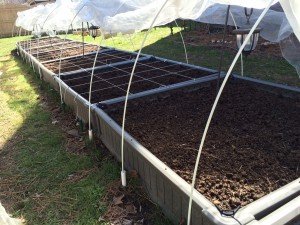 The square foot grids serve the useful purpose of being guides for plant spacing throughout the year when individual squares are turned over for different seasonal plantings, but they also serve as something of a study in contrast with their clean, angular lines soon to be mostly obscured by nature's riot of a summer garden.*A note on the continuing deception of Punxsutawney Phil - as I was preparing garden beds today I saw that the beautiful weather had tricked some of the Jersey Knight asparagus into putting up tender shoots despite two nights of freezing temps headed my way later in the week.
The square foot grids serve the useful purpose of being guides for plant spacing throughout the year when individual squares are turned over for different seasonal plantings, but they also serve as something of a study in contrast with their clean, angular lines soon to be mostly obscured by nature's riot of a summer garden.*A note on the continuing deception of Punxsutawney Phil - as I was preparing garden beds today I saw that the beautiful weather had tricked some of the Jersey Knight asparagus into putting up tender shoots despite two nights of freezing temps headed my way later in the week.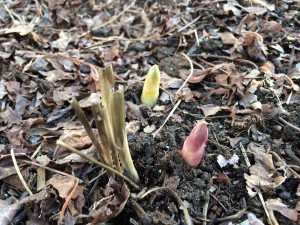
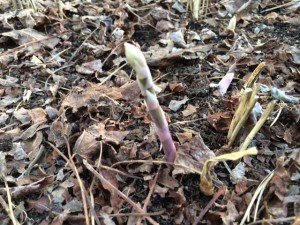 2015 was the first year in the ground for my 2 year old crowns so they were left in peace all year without a single spear being harvested. I am determined to get to sample a few spears this year and will be covering them with cloches on the coldest nights to protect the bounty that must be split between the crowns and me this year.
2015 was the first year in the ground for my 2 year old crowns so they were left in peace all year without a single spear being harvested. I am determined to get to sample a few spears this year and will be covering them with cloches on the coldest nights to protect the bounty that must be split between the crowns and me this year.
Urban Growing - By The Numbers
- 200% - the increase in households participating in community gardens from 2008 to 2013
- 35% - the number of households growing food at home or in a community garden
- 88% - the number of people that do not garden but still want to see gardens in their neighborhood
This data was excerpted from the excellent article "Urban Growing" by Christine Jordan Sexton, published on Realtor.org. There are many other interesting numbers in the article such as $1.2 billion being the amount millennials spent on food gardening in 2013 if you happen to be looking for a business opportunity or 750 being the number of mostly poor families helped by Southside Community Land Trust in Providence, RI to grow their own food if you happen to be looking for a way to give a hand up to those in need.But for me, it was the 88% of people wanting to see gardens in their neighborhood that do not garden themselves number that was most interesting. It's no surprise at all that gardeners like to see other gardens in their neighborhood, but it is news to me that people that do not garden also take pleasure in the sight of food growing in a neighborhood. Kudos to you 88%! C'mon over, I'll have some extra tomatoes in August :)
Starting My Garden Early
While Punxsutawney Phil and the meteorologists work out their differing predictions for the end of winter, growers are already hard at work preparing for spring, summer and fall.January plant starts included cabbage,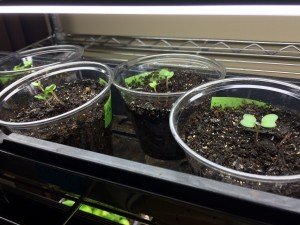 chili peppers, bell peppers and rosemary.
chili peppers, bell peppers and rosemary.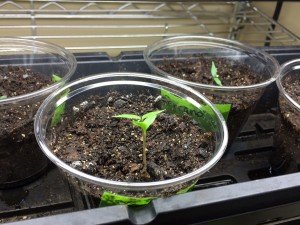 Now that February has begun, the seed starting kicks into high gear with oregano, collards and lots and lots of tomatoes with 8 varieties and a total of 38 plants this year!
Now that February has begun, the seed starting kicks into high gear with oregano, collards and lots and lots of tomatoes with 8 varieties and a total of 38 plants this year!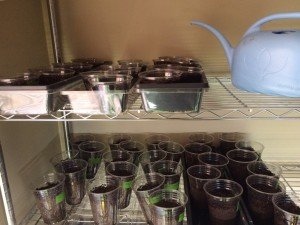 The new starts will welcome roommates in my growing nook for the cilantro and basil I grow indoors each winter. I purchased inexpensive shop lights, metal wire shelving units and florescent tubes 5 years ago so I never have to go a grey winter day without their bright colors and fresh flavors complimenting meals.
The new starts will welcome roommates in my growing nook for the cilantro and basil I grow indoors each winter. I purchased inexpensive shop lights, metal wire shelving units and florescent tubes 5 years ago so I never have to go a grey winter day without their bright colors and fresh flavors complimenting meals.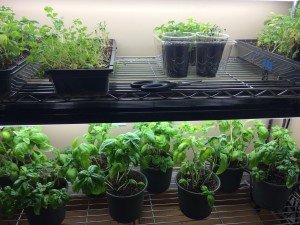 The minimal, initial investment for the equipment has more than paid for itself already and now as my garden diversifies and the number of indoor starts continue to expand each year with no additional infrastructure costs to date, I consider this money extremely well spent.Happy Spring, whenever it comes :)
The minimal, initial investment for the equipment has more than paid for itself already and now as my garden diversifies and the number of indoor starts continue to expand each year with no additional infrastructure costs to date, I consider this money extremely well spent.Happy Spring, whenever it comes :)

